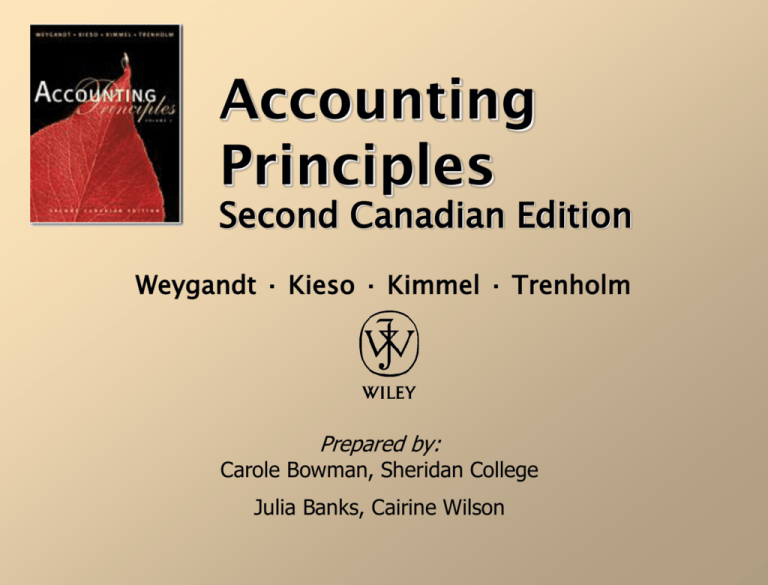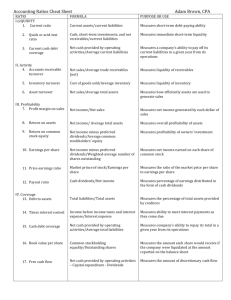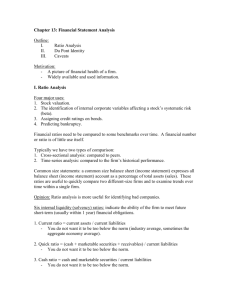
Accounting
Principles
Second Canadian Edition
Weygandt · Kieso · Kimmel · Trenholm
Prepared by:
Carole Bowman, Sheridan College
Julia Banks, Cairine Wilson
CHAPTER
18
FINANCIAL STATEMENT
ANALYSIS
BASICS OF
FINANCIAL STATEMENT ANALYSIS
• Analysing financial statements involves
evaluating three characteristics of a company:
1. its liquidity
- short-term creditor
2. its profitability – long-term creditor and investors and
shareholders
3. its solvency
- long-term creditors, investors, and shareholders
COMPARATIVE ANALYSIS
• Three types of
comparisons:
1. Intracompany basis
2. Intercompany basis
3. Industry averages
1. Intracompany Basis
• Compares an item (i.e. cash) or relationship
(i.e cash as a % of current assets) on a
financial statement within the company in a
given year with the same item or
relationship in one or more prior years.
• Useful for detecting changes in financial
relationships and significant trends within a
company
2. Intercompany Basis
• Compares an item (i.e. cash) or relationship (i.e
cash as a % of current assets) on a financial
statement within the company in a given year
with the same item or relationship in one or more
competing companies.
• (i.e. comparing Sear’s total sales with The Bay’s
total sales)
• Useful for understanding a company’s
competitive position
3. Industry Averages
• Compares an item or financial relationship of a company
with industry averages (or norms)
• Averages found in annual publications such as Dun &
Bradstreet Canada’s Duns Financial Profile, The
Financial Post’s Industry Reports, and Statistics
Canada’s Financial Performance Indicators for
Canadian Business.
• Provides info about a company’s relative performance
within the industry.
COMPARATIVE ANALYSIS
•
Three tools:
1.
Horizontal analysis ( or Trend Analysis)
Evaluates a series of financial statement data over a period of
time.
Used primarily in intracompany comparisons
See pg. 893 – 894
2. Vertical analysis ( or Common Size Analysis)
Evaluates financial statement data by expressing each item in a
financial statement as a percentage base amount for the same
period of time
Used in both intracompany and intercompany comparisons.
See pg. 895-897
3. Ratio analysis
Expresses the relationship among
selected items of financial statement data.
Used in intracompany, intercompany, and industry average
comparisons.
HORIZONTAL ANALYSIS
Determines an increase or decrease that has taken place.
May be expressed as either a $ amount or as a % percentage.
Change
since base
period
Current year amount — Base year amount
———————————————————————
Base year amount
ANY COMPANY INC.
Assumed Net Sales
For the Year Ended December 31 (in millions)
2003
$ 6,562.8
127%
2002
2001
2000
1999
$ 6,295.4 $ 6,190.6 $ 5,786.6 $ 5,181.4
121%
119%
112%
100%
For 2003 : ( 6562.80 - 5181.40 ) / 5181.40 = .266 = 27%
Or : 6562.8 / 5181.4 = 1.266 = 127%
VERTICAL ANALYSIS
• Expresses each item in a financial statement as a
percent of a base amount (total assets or net
sales)
• See pages. 895-897
ANY COMPANY, INC.
Condensed Balance Sheets (Partial)
December 31 (in millions)
Assets
Current assets
Capital assets
Other assets
Total assets
2002
Amount
$1,496.5
2,888.8
666.2
$5,051.5
Percent
29.6
57.2
13.2
100.0%
2001
.
Amount
Percent
$1,467.7
30.1
2,733.3
56.9
636.6
13.0
$4,837.6
100.0%
RATIO ANALYSIS
Liquidity Ratios
Measure short-term ability
of the enterprise to pay its
maturing obligations (
current liabilities) and to
meet unexpected needs for
cash.
Profitability Ratios
Revenues
Since 1892
-
Expenses
=
Net
Income
Measure the income or
operating success of an
enterprise for a given period
of time.
Solvency Ratios
XYZ
Co.
Measure the ability of the
enterprise to survive over a
long period of time.
Ratio Analysis
Can be expressed in 3 ways:
Example:
1.
Current Assets are $33.4 million
Current Liabilities are $13.8 million.
By Percentage:
Current assets are 242% of current liabilities.
2. By Rate:
Current assets are 2.42 times greater than current
liabilities.
3. By Proportion:
The relationship of current assets to liabilities is
2.42 : 1.
LIQUIDITY RATIOS
Interested parties include bankers and suppliers.
•
•
•
•
•
•
•
Current ratio
Acid test ratio
Cash current debt coverage ratio
Receivables turnover
Collection period
Inventory turnover
Days sales in inventory
CURRENT RATIO
Working Capital Ratio
• Measures short-term debt-paying ability
Current Ratio =
Current Assets
Current Liabilities
• Limitations: Portion of CA may be tied
up in uncollectable A/R’s or slow moving
inventory.
• Useful when comparing to industry
averages
(Discussed in Chapter 4)
ACID TEST RATIO
• Measures immediate short-term debt-paying
ability
Acid test ratio =
Cash + temporary investments + net receivables
Current liabilities
• Does not include Inventory and Prepaids
• Compare it to the industry average. Generally
a 1.0 : 1 is quite adequate.
• Limitations: Year end account balances may
not represent position during most of the year.
CASH CURRENT DEBT COVERAGE RATIO
• Measures short-term debt-paying ability (cash
basis) See page 901-902
Cash current debt coverage ratio =
Cash provided by operating activities
Average current liabilities
• Average Current Liabilities is calculated by
taking the balance of the current liabilities at
the beginning of the fiscal period and at the
end and dividing it by 2.
(Discussed in Chapter 18)
RECEIVABLES TURNOVER
• Measures liquidity of receivables – the number of times,
on average, receivables are collected during the fiscal
period. The faster the turnover, the current and acid test
ratios are considered to be more reliable.
Receivables turnover =
Net credit sales
Average net receivables
• Net Credit Sales = Net Sales – Cash Sales
•
•
Net Sales = Total Sales – Sales Returns and Allowances and Sales Discounts.
Average Net Receivables = Beginning Net Receivables + Ending Net Receivables
divided by 2
(Discussed in Chapter 9)
COLLECTION PERIOD
• Measures number of days receivables are
outstanding. (The number of days it takes to
collect the receivables.)
Collection period =
365 days
Receivables turnover
• Used to assess a company’s credit and
collection policies.
• Collection period should not exceed the credit
term period.
(Discussed in Chapter 9)
INVENTORY TURNOVER
• Measures liquidity of inventory – the average
number of times the inventory is sold during the
period.
Inventory turnover =
Cost of goods sold
Average inventory
• Average Inventory =
Beginning Inventory + Ending Inventory
2
(Discussed in Chapter 5)
DAYS SALES IN INVENTORY
• Measures number of days inventory is on
hand or average selling time.
Days in inventory =
365 days
Inventory turnover
(Discussed in Chapter 5)
PROFITABILITY RATIOS
Measure
income or operating success for a specific period
of time
Profitability impacts company’s ability to obtain debt and
equity financing.
•
•
•
•
•
•
Profit margin
Gross profit margin
Cash return on sales
Asset turnover
Return on assets
Return on common
shareholders’ equity
•
•
•
•
•
•
Book value per share
Cash flow per share
Earnings per share (EPS)
Price-earnings (PE) ratio
Payout ratio
Dividend yield
PROFIT MARGIN
• Measures net income generated by each
dollar of sales
Profit margin =
Net income
Net sales
(Discussed in Chapter 5)
GROSS PROFIT MARGIN
• Indicates a company’s ability to
maintain its selling price above its cost of
goods sold.
Gross profit margin =
Gross profit
Net sales
(Discussed in Chapter 5)
CASH RETURN ON SALES
• Measures net cash flow generated by
each dollar of sales
• Measures profit margin based on cash
basis of accounting. Does not include
sales in A/R.
Cash return on sales =
Net cash provided by operating activities
Net sales
(Discussed in Chapter 18)
ASSET TURNOVER
• Measures how efficiently assets are used
to generate sales indicates the dollar
of sales produced by each dollar of
assets.
Asset turnover =
Net sales
Average total assets
(Discussed in Chapter 10)
RETURN ON ASSETS
• Measures overall profitability of assets
Return on assets =
Net income
Average total assets
(Discussed in Chapter 10)
RETURN ON COMMON
SHAREHOLDERS’ EQUITY
• Measures profitability of common
shareholders’ investment
Return on common shareholders’ equity =
Net income
Average common shareholders’ equity
Common Shareholder’s Equity =
Total Shareholder’s Equity – Preferred Shares
(Discussed in Chapter 14)
BOOK VALUE PER SHARE
• Measures the equity (net assets) per
common share
Book value per share =
Common shareholders’ equity
Number of common shares
(Discussed in Chapter 14)
CASH FLOW PER SHARE
• Measures the net cash flow per common
share
Cash flow per share =
Net cash provided by all activities
Number of common shares
• Don’t need to know
(Discussed in Chapter 18)
EARNINGS PER SHARE (EPS)
• Measures net income earned on each
common share
• This is only meaningful when used as an
intracompany comparison
Earnings per share =
Net income
Number of common shares issued
(Discussed in Chapter 15)
PRICE-EARNINGS (PE) RATIO
• Measures relationship between market price per
share and earnings per share
• Reflects investors’ assessment of a company’s
future earnings.
• Share sold for “ratio” times the amount that was
earned on each share.
Price-earnings ratio =
Share price
Earnings per share
(Discussed in Chapter 15)
PAYOUT RATIO
• Measures % of earnings distributed in the form
of cash dividends
Payout ratio =
Cash dividends
Net income
• Companies with high growth rate usually have
low payout ratios because they reinvest most of
their net income in the business.
• Companies with stable earnings usually have high
payout ratios.
(Discussed in Chapter 15)
DIVIDEND YIELD
• Measures rate of return earned from
dividends
Dividend yield =
Cash dividends per share
Share price
Cash Dividend Per Share =
Cash Dividend / # of Common Shares
(Discussed in Chapter 15)
SOLVENCY RATIOS
Measures a company’s ability to survive
over a long period of time.
Ability to pay interest on long-term debt
and repay principal when it comes due.
Ratios include:
• Debt to total assets
• Interest coverage
• Cash interest coverage
• Cash total debt coverage
DEBT TO TOTAL ASSETS
• Measures % of total assets provided by
creditors
Debt to total assets =
Total liabilities
Total assets
(Discussed in Chapter 16)
INTEREST COVERAGE
• Measures ability to meet interest payments
as they come due based on accrual
method.
Interest coverage =
Income before interest expense
and income tax expense (EBIT)
Interest expense
• The higher the number the better
(Discussed in Chapter 16)
CASH INTEREST COVERAGE
• Measures cash available to meet interest
payments as they come due (cash basis)
Cash interest coverage =
Income before interest expense, income tax
expense, and amortization expense (EBITDA)
Interest expense
(Discussed in Chapter 16)
CASH TOTAL DEBT COVERAGE
• Measures long-term debt-paying ability (cash
basis) without having to liquidate assets
Cash total debt coverage ratio =
Net cash provided by operating activities
Average total liabilities
• If CTDC was .2 times, then it would mean that
it would take five years (1/.2) to generate
enough cash to pay off all its liabilities.
(Discussed in Chapter 18)
LIMITATIONS OF FINANCIAL
ANALYSIS
• Estimates – amortization,
uncollectable accounts etc.
• Historical cost – does not account
for inflation, recessionary effects
etc.
• Alternative accounting methods –
FIFO vs. LIFO, global differences
• Atypical data - year end balances
may not reflect average activity
that occurs throughout the year
• Company Diversification
COPYRIGHT
Copyright © 2002 John Wiley & Sons Canada, Ltd. All rights reserved.
Reproduction or translation of this work beyond that permitted by
CANCOPY (Canadian Reprography Collective) is unlawful. Request for
further information should be addressed to the Permissions Department,
John Wiley & Sons Canada, Ltd. The purchaser may make back-up copies
for his / her own use only and not for distribution or resale. The author and
the publisher assume no responsibility for errors, omissions, or damages,
caused by the use of these programs or from the use of the information
contained herein.





